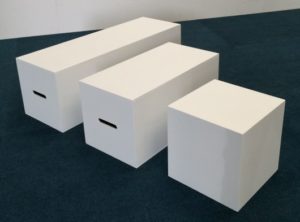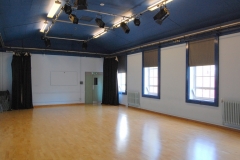by Jon Primrose
UNDER CONSTRUCTION
This page is written to help folk who are specifying equipment for a performance space or drama rehearsal space in an educational context. It will also be of interest to those with existing spaces who have a budget to improve them.
It’s written from the perspective of the United Kingdom, but the requirements (if not the precise details) will apply internationally.
The space used for drama within any kind of institution varies from a newly converted fully-specified “black-box” studio via a purpose-built proscenium arch stage with raked seating, to a quiet corner of the gym.
What’s needed to study drama?
The straight answer is “almost nothing”. Drama workshops, rehearsals and performances can (and do) happen in any space. The main requirement is for even lighting, and a flat floor area. Below, I’ll have a look at some elements that can be mixed and matched to help make a given space more drama-friendly.
In schools, Drama is obviously much more than “a performance”. Space is needed for experimentation with props, costumes, puppets, basic lighting and other resources, depending on the level of the students.
When you’re planning or refurbishing a space, it’s vital to think through as many possible scenarios as possible to try to find any flaws in your scheme. The following provides some areas for you to think about and discuss with the folk in charge.
Heating / ventilation
The specification for a dedicated Drama space is a very difficult thing to tie down.
Usage may vary from an energetic warm-up involving running around, to a script readthrough where the whole class is stationary for an hour. The main requirement is that the space can be easily ventilated (for example, by opening windows) and heating can be controlled from within the space (either by turning radiators on, or by remotely controlling a more complex system). Ideally, both extract (to clear stale air) and supply ventilation (fresh air from outside) should be available.
The ventilation system should be as silent as possible.
Care should be taken to be absolutely clear about the kind of use to which the room may be put.
Take additional care when you’re asked about the maximum number of occupants for the room. A space which is routinely used for a class of 15 doing physical work may occasionally (once a term, for example) be used for a small performance with an audience of 60. The air conditioning and ventilation requirements for 15 differs considerably from that for 75…
Colours
As we move further into the 21st century, the easy answer to the question “What colour should the drama room be” is no longer “Black, of course”. Dark colours are obviously necessary to minimise lighting reflections during performances, but this function can often be performed by black curtains (known as “tabs”) around the walls of the space. When these are opened, there’s no reason why the space can’t feel light and airy. The area that the tabs do NOT cover should obviously be painted a dark colour, so that when the tabs are closed, the spectator’s eye is not drawn to any patches of light wall or ceiling.
Storage
However much storage space you have, it will never be enough. Drama spaces have the tendency to collect rubbish and debris in dark corners – this should be discouraged by minimising the amount of “stuff” stored in the space. Try to find cupboards outside the space to put all the bits and pieces in. If that’s not possible, then a few office surplus steel cupboards in a corner are better than nothing. Set up systems for organising the space, and encourage people to stick to them.
A separate space should be available for storing lighting equipment, and another space should be found for props and costume. Ideally, a high-ceilinged area adjacent to the performance space would be available for storage of large scenery (flats).
Avoid folk bringing food and drink into the space by having a foyer outside which can be used for eating and drinking – this also helps to minimise clutter (and potential hygiene problems) by not having waste bins in the room.
Tabs (Curtains)
Domestic quality curtain tracks or poles aren’t suitable for use in a drama studio – they’re not designed for the abuse that they will receive. A range of heavy-duty tab track systems are available, all based on a metal track with plastic wheeled runners which are attached to the top of the tabs. If the tabs are double-sided (with, say, black on one side and white on the other) a double section of track can be setup to allow the tabs to be reversed easily. White tabs can transform the space, allowing creative use of coloured lighting and projection. Alternatively, a single-sided tab can be used, with a lightcoloured wall behind it for projection.
If you already have some tabs which are a few years old, you need to find out if the tabs are flame retardant or if they need to be treated (or re-treated) to be flame retardant. Durably Flame Retardant (DFR) material means the tabs can remain flame retardant even after a few washes. Non-Durably Flame Retardant (NDFR) needs re-treated after each wash.
So-called inherently flame retardant (IFR) material is the best to use for new tabs, as they will not lose their flame-proofing. If you’re in doubt about the fabric used in your tabs, seek advice from the fire brigade.
It may be sensible to allow a 1.5m gap between the back wall of the theatre and the tab track to allow for storage of scenery, and to allow performers to walk behind the curtain in order to make an entrance. This “crossover” will prove invaluable. It may be necessary to have another curtain hanging directly up against the wall so that bare walls aren’t exposed when a performer parts the curtain to enter.
Blackout
Where possible, windows should have full blackout capabilities. Purpose-made blackout blinds are the most effective, but if the windows aren’t double-glazed close-fitting blinds can produce odd creaks and billows as the wind finds a route into the space. The next best option is thick black curtains. It’s obviously important these cover the window completely, ideally with a pelmet surrounding the top and sides of the curtain, to exclude as much light as possible. In the absence of the budget to achieve the above, anything is better than nothing. Whatever cloth is chosen for the curtains, it should be inherently flame-retardant. Theatrical suppliers will have a number of options for types of cloth, and a friendly person with a sewing machine will be able to help. Professional-standard curtain tracks are ideal, but this may be beyond the budget of many departments (see “tabs”, above). As the tab track uses removable runners, the curtains should have snap hooks at the top.
Fixtures and Fittings
Metal electrical outlets should be used wherever possible. The plastic-cased fittings will require replacement if they are damaged by the lightest knock.
Including USB power sockets in the sockets will help students keep devices powered (if required) [link to example from TLC Direct]
(UK-specific) If you have Exit signage inside the space, it should be of the new design with a green design on a black background, NOT the usual green on white. This reduces the amount of light leaking onto the space. [link to example from DC Emergency Systems Ltd]
Seating
If you have loose chairs in the drama space, it’s obviously important they can stack out of the way. Make sure you have a chair trolley suitable for the chairs you have – it’s not advisable to rely on having strong people around to carry stacks of chairs. If you’re using chairs in a performance situation, they should be capable of being fixed together (to comply with licencing standards, even if you’ve not got a licence; the standards are a sensible set of guidelines to follow). If you’re using chairs on a platform for audience seating, make sure you meet (or exceed) the licencing requirements.
This, along with many other aspects of technical theatre is the subject of a set of guidelines published by the Association of British Theatre Technicians (ABTT). These guidelines cover spacing between seats, width and number of aisles, handrails etc. and should be read thoroughly before embarking on any auditorium-constructing exercise.
The number and position of fire exits in the space is rarely able to be changed, but ensure your seating layout allows easy access to these exits, and that the aisles leading to the fire exits are wide enough. Your local fire station will be able to provide advice.
There are a number of possible relationships between the acting area and the audience, which can be categorised as follows:
1) End On
The audience is seated in rows, all facing the stage which is situated at one end of the room. This is the standard layout for proscenium arch venues.
2) Thrust
The stage extends into the audience area so that the audience is seated on three sides. For a true thrust space, there are equal numbers of audience on each side, although this is often difficult to achieve in a rectangular space.
3) In-the-round
The audience completely surrounds the acting area, which might be circular or rectangular. There are commonly actor entrances between blocks of audience. This can often provide an incredibly intimate connection between the performers and the audience.
4) Traverse
The audience is divided into two blocks which face each other, with the acting area filling the space between the blocks.
5) Promenade
Not strictly a seating layout, but it can be one of the most exciting actor/audience relationships. The audience follows the action around the space – they normally stand, but there may be a number of “stations” where they can perch for longer scenes – these may be benches, or simply rostra levels.
Staging units
Multiple levels can transform a space. Many companies supply wooden or metal units to form flexible stages within a drama space. If you’re buying these, it’s important to have a sensible storage space for them, ideally outside the drama space. Before buying a system based on large metal frames, ensure you can move them from the storage space to the theatre safely and with due regard to manual handling regulations. Smaller lighter-weight systems can be bought, which still produce a vast range of different options, and which are easier to move around for younger (or older!) members of the group. See also Drama Blocks below.
Flooring
The installation of a specific floor for a drama space is beyond the dreams of most, but if a space is being built new or refurbished, then it’s something to have a strong opinion about.
If the space is being used for physical work involving bare-foot work, any sort of carpet should be avoided, as it can produce static electricity, or produce carpet burns. A wooden floor is ideal, and many manufacturers now produce “sports floors” which can be fitted into an existing space to provide a semi-sprung finish. However, for a multi-purpose drama room where students are mostly working on text, and doing limited physical work, a carpet is fine.
The only requirement then is to avoid strong patterns on the carpet or tiles. A plain solid (relatively dark) colour is the best option. If there’s an option to incorporate a custom design or layout of carpet tiles, a border of approximately 1m can be helpful to define ‘clear space’ – chairs, bags etc can remain outside the performance space, and students can make an ‘exit’ off the main carpeted area.
A brand-new wooden sprung floor is expensive. To avoid damage to the floor, limited furniture should be brought into the studio, and no shoes should be worn. This can make the room virtually unusable, however, as chairs and costume shoes are often a vital part of rehearsals. To avoid damage, a removable vinyl dance floor can be laid on top of the wooden floor. Dance floor is available in black to minimise light reflections during performance situations, and is a good investment. Always use specially made dance floor tape to join the sections of floor together. It’s harder wearing than gaffa tape, and won’t leave a sticky residue on the dance floor or surrounding wooden floor.
If there’s a lot of physical work happening in a session, thick judo-type mats can be used to form a cushioned floor for a drama room. Although these can be difficult to store and handle, the advantages far outweigh the disadvantages. If the mats don’t fill the room completely wall to wall, they can drift apart leading to potential trip hazards. The areas between the mats can also get very dusty, requiring regular vacuuming. If the mats are down semi-permanently, a frame can be built to surround them and hold them in place. A thick canvas covering with eyelets can be custom-made to fit the frame and elastic “shock-cord” can hold the canvas taut, forming an excellent surface for physical work or yoga.
Furniture
Chairs can play a number of roles in a drama space, aside from the obvious (see Seating, above). They can be stood on (with care), crouched behind, carried and many other permutations. It makes sense to ensure the chairs in the drama space are of solid construction and can take the potential abuse to which they’ll be subjected. It’s also handy to have a few wooden “character” chairs around in addition to the school standard-issue ones.

Drama blocks
Drama Blocks
Multi-purpose black or white wooden blocks find a massive number of uses, in a similar way to chairs. They can also be grouped together to form easily-managed levels to break up the level floor. The only slight problem with them is finding somewhere to store them.
Scenery
Depending on the size of the room, you could have a few flats (wooden framed canvas screens) to help divide the space up, and to create ‘offstage’ areas. Flats made with white cloth (such as calico) can also be used as shadow screens.
Wooden rectangular door frames (free-standing) are also useful to help denote entrances / exits etc.
Sound System
A moveable sound system (either on a wheeled trolley or built into an equipment ‘rack’) is the ideal, but a sensibly positioned permanent system is fine.
The system needs the ability to connect (at least) 3 microphones, along with a CD player (or USB media player if CDs aren’t needed) and a minijack connection for a laptop or iPod / MP3 player. There should be a simple mixer to enable you to adjust levels, an amplifier and a pair of speakers.
The speakers should be connected using speakon locking connectors, and ensure you ask for 2 sets of cables – one short set to connect the speakers adjacent to the sound system, and another set of cables to put the speakers elsewhere in the room.
In an ideal world, the system (and cables, microphones, microphone stands etc) could be locked away to prevent unauthorised use (or theft).
Acoustics
The way sound behaves in a drama space is massively important. A room with flat walls, a wooden floor and no curtains, will have a reverberant acoustic, in which sound waves bounce all over the place before dying out. The introduction of curtains on the walls, or the placing of some scenery at angles to the wall, can break up this reverberant effect and make the sound more intelligible. The addition of an audience to the space, or even the simple laying out of chairs for them, can radically alter the way sound behaves in the space.
In a room with odd shaped or curved walls, the acoustic can be significantly different and “dead-spots” may be introduced making it difficult for music or speech use. For anything other than a rectangular room, the employment of an acoustics expert will be a sound investment (no pun intended). The science of acoustics is thankfully beyond the scope of this page, and the methods for curing acoustic problems permanently are often beyond the budget of many organisations.
Stage Lighting System
See the separate page about lighting systems
Doors
It’s essential the doors into the performance space open outwards. This enables entrances to be made by performers without the doors taking up space inside the room, and more importantly, enables an audience to make an easy exit in the event of a fire or other emergency.
Site-specific Performance
An increasingly interesting area of performance is this form of installation art, where a place forms the inspiration for a piece of devised theatre, which is then performed in that place. A whole host of additional considerations comes into play, primarily to do with satisfying the requirements of the fire officer. Even if your performance is not public, it’s essential you use these official requirements as a minimum level of safety.
Thorough risk assessments should be performed, with careful regard to the safety of audience members, especially if the performance is outdoors. The space will be totally unfamiliar to the audience, and they place a large amount of trust in the organisers of the event. Clear signage should be used, there must be adequate lighting with emergency backup in the event of power failure and a number of ushers appropriate to the size of the audience, armed with torches. Radio communication is often useful on large outdoor sites, and first aid kits and mobile phones should be on site at all times.
There should also be a formal undertaking to return the space to it’s pre-show condition immediately after the final performance, with all rubbish taken off site.
Waste
Try to avoid having bins inside the space. Encourage students to clear up after themselves, and take their rubbish out of the space after each session.
Flexible Space, Multi-purpose Space, Drama Space, A Space for Drama



